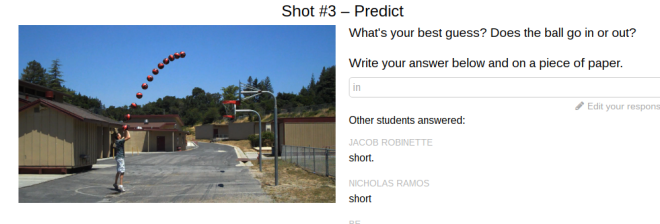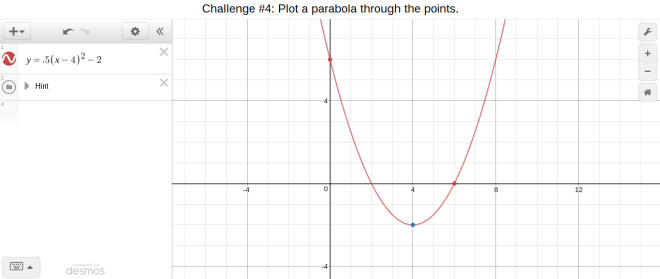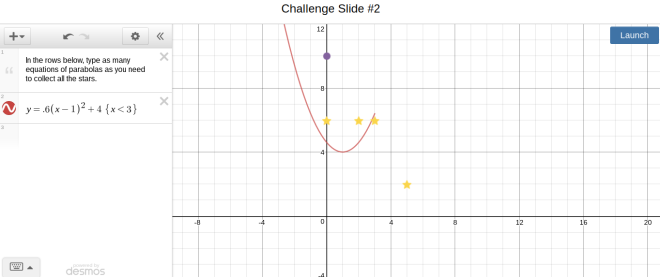In this chapter of math, we studied parabolas and how they are affected by changes in their equations. We practiced with a program called DESMOS. Our teachers were able to create an online curriculum around experimenting through 5 activities.
Will It Hit the Hoop?
The first one was centered around predicting whether or not a basketball would go inside the hoop. In this activity I learned what a parabola looks like and how they are used in real life. For our journal topic the next day, we wrote a list of things that resemble parabolas. Some items on my list were: water fountain, slinky, world’s orbit, and hose.

Polygraph 1
In this activity, we played an interactive game where we were partnered up to guess a specific parabola. There was a guesser and a player. The guesser would pose yes-or-no questions to the player, who would answer. Then the guesser would eliminate the parabolas that don’t meet the circumstances of the answer they were given. At first, we used basic vocabulary to describe our partner’s chosen parabola. We used words such as wide, narrow, and upside down. When we returned to this activity again, we were able to use our knowledge like in this screenshot of the game when I was the guesser:

Polygraph 2
In this activity, we learned about vocabulary that would benefit our discussions about parabolas. We learned terms such as concave, vertex, and x-intercept. From this, we were able to use our newly-extended vocab in our return to the last activity, Polygraph 1.

Match My Parabola
In this activity, we learned how manipulating the equation changes how the parabola looks and its position. Our goals was to create a parabola that fit into the dots in the arrangement. This was very helpful for me, seeing the similarities and differences in each equation. For example, this activity included challenges like the picture below, which allowed me to understand how opposite operations can affect where a parabola is positioned.


Marbleslides: Parabolas
In this activity, we were able to create our own equations and figure out how to catch all the stars in the predetermined arrangement. I really enjoyed how this activity felt more like a game and allowed me to just play around and made me think deeply about how the parabolas get affected when changes are made to its equation.

Problem Evaluation- At first, I was hesitant to use an online program to learn math because I was taught math in the traditional way. I worried that I wouldn’t be able to understand as well if I didn’t have it in paper in front of me. Now that I’ve used DESMOS, I am thankful that we took a digital approach to graphing because it always frustrated me when I would have to make a graph every time I graphed a new equation. DESMOS allowed me to test out different equations at the same time and how minor changes in it can make a huge difference. I would be more open to online programs other than DESMOS now that I see how these can used as tools in learning other than repeating problems on a worksheet.
Self-Assessment- This semester, my goal was keep questioning when I didn’t understand. One way that I displayed this was when I would ask my table mates if I didn’t understand what to do on DESMOS.
Edits- During peer critique, a classmate suggested that I fill out a description for Polygraph 1, so I did that. I forgot to make a description for that one. She also suggested that I elaborate on the class takeaways, so I added more to that section.
Class Takeaways- “If x is negative, it is concave down.” In one of the activities, we learned that concave down could also be described as a frown. We can use association to help us remember math terms.
“All parabolas have equations.”
“Adding K moves parabola up that many times.” We learned that the absolute value of the value of K in vertex from will move the parabola that many times across the y-axis.
“Needs x^2 in equation to be quadratic.”
“Vertex means turning point.” We learned new vocabulary to better explain parabolas.